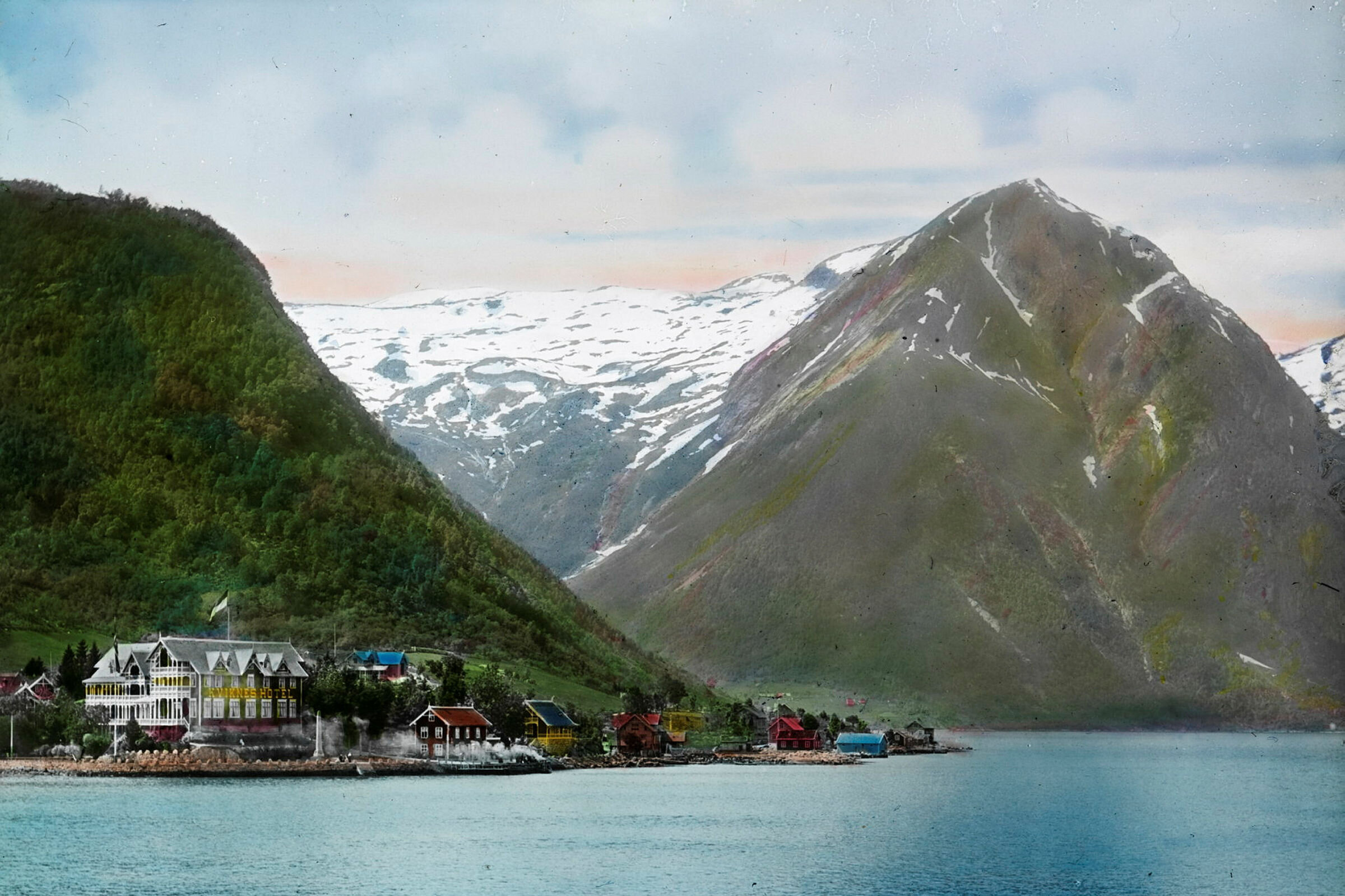Sustainability Policy
Look at the two photographs below. They’re both hand-colored prints of Balestrand from the late 1800s. This first one shows the mountain Vindreken in the background, with the harbor, Kviknes Hotel, and artists’ villas in the foreground. This scene has hardly changed today.
An image of Balestrand from the late 1800s. The mountains and many of the buildings are the same.
The next photo shows a laksevarp, a structure used to catch salmon, which came to the Sognefjord in enormous masses. There were hundreds of these around Balestrand, and they fed many families. But no more — there is not a single one left, because there aren’t enough salmon left to fish. The reason is pollution and unsustainable fishing.
A laksevarp, used for salmon fishing, in Balestrand in the late 1800s. Today they are all gone.
How can we make sure Balestrand’s tourist traditions won’t rot away like the laksevarp? This would be a tragedy for both guests and villagers alike.
We must together protect the resources our tourist traditions are based on: the dramatic landscape, the clean air and water, the plants and animals, and our stories of the past.
What kind of future can we expect in our village if we protect these resources?
Our vision of the future
It’s November 2050. A lazy weekday in the center of Balestrand, and the sun has started to go down behind the mountain. In the distance the silhouette of the express boat glides towards Balestrand on its way to Bergen. The lights of Kviknes Hotel reflect on the fjord.
You can hear the creaking of boats rubbing against the dock, mixed with laughter from a few kids playing in the park. Some speak Norwegian to their parents, others Spanish.
On the main road, lined by freshly-painted wooden houses and well-kept gardens, a small, warmly-dressed group is guided out of the village center. A neighbor outside raking up leaves waves as they pass.
A young man opens up the door of the Balestrand Adventure House for a group returning from a boat tour. A woman in the group smiles and thanks him. Her hair is a mess from the wind, but she doesn’t seem to notice.
Doesn’t this sound like nice place to visit? And a nice place to live?
The ingredients in this vision are:
A steady flow of guests
Longer stays, fewer guests
More tours booked per stay
This is what Balestrand needs to make sure that our tourism tradition will stay strong and not rot away.
Of course, we must also run our office in the village center while using minimal resources, recycling, treating our employees fairly, and so on. Today these things are as obvious and basic as brushing your teeth, so we’ll give them no more attention here.
No more “tourist season”
Most places in Norway have a short, hectic summer and a long, sleepy winter. This creates all kinds of waste: Empty cabins and rooms in the winter, and not enough in the summer. In summer it’s impossible to hire enough workers, and in winter it’s impossible to keep them. In summer we can’t give guests the attention they deserve, and in winter there aren’t any guests at all. In the worst cases, a village can become a sweaty, overcrowded tourist depot during the summer, and a depressing ghost town during the winter. Who wants that?
Both guests, locals, and our environment will benefit from a longer season. We’re doing what we can to make this happen. We’ve closed our village to cruise ships, the biggest groups who stay the shortest. Every year we extend the season of our daily tours, and we offer private tours all through the year. And we’ve priced our tours so that we can stay profitable with smaller groups and fewer guests.
Longer visits
Most of the waste of travel comes with transport: the pollution of planes and cars, waiting in lines, endless cleaning of rooms. If guests stay shorter and shorter, this type of waste grows, and villages are transformed from proud tourist destinations to shabby waystations.
What if you just stayed a while instead of rushing around? The main obstacle is not enough things to do, or not knowing about things to do. Our marketing strategy is to spread information that you can stay in our area for many days, really. See our guide to things to do in Balestrand!
More tours booked
There are many hours in a vacation. The most memorable are almost always those spent on guided tours. If guests come with their own ideas, their own food, their own campers, they risk missing the whole point. Would you visit a friend like that?
The guests never really get below the surface of what a place is like, and the locals never see any money from the visitors. What’s the point?
There is nothing quite like a guided tour, a meeting between a local and a guest, that can take your visit to a higher level. We do what we can to make it easy for you to find a tour that fits you.
We meet every Thursday to talk about how to better meet our guests. We have an system for collecting feedback from our guests after each tour. Our suppliers sign contracts that require high quality standards. And we make sure everybody’s offerings are easy to compare and book, with an easy booking system, standard cancellation policy, and price categories.
You’re one of us
Tourism makes life better in Balestrand. It really does. Few villages the size of Balestrand have such accessible hiking trails as Raudmelen or Keipen, or such good restaurants as Kviknes Hotel and the Cider House. Or a year-round open café like Peters plass. Or a movie theater. The list goes on and on.
A good place to live is a good place to visit. We’re in this together. Why not book a few tours and stay a while?


